Development of Representative Urban Driving Cycles for Congested Traffic Conditions in Guayaquil Using Real-Time OBD-II Data and Weighted Statistical Methods
Abstract
1. Introduction
2. Materials and Methods
2.1. Description of the Study Area
- A large flow of vehicles;
- Linking the main population centers;
- Numerous squares and crossroads;
- Access to public transport networks for the purpose of normal driving [28].
2.2. Vehicle Selection
2.3. Measuring Instruments and Data Collection
2.4. Data Collection Methodology
3. Data Analysis Methods and Techniques
3.1. Data Analysis Tools
3.2. Data Analysis Methodology
3.3. Data Processing Methodology
- Y represents the weighted mean/median of the deviations of all parameters from the arithmetic mean.
- represents the weighting coefficient.
- represents the value of the variable.
- represents the mean/median of the variable.
- represents the deviation from the mean/median with absolute value.
4. Results
4.1. Pilot Test
4.2. Data Collection
4.3. Analysis of Data Obtained
4.4. Normality Test
4.5. Weighting Criteria
4.6. Characteristic Curves
4.7. Comparisons with Other Driving Cycles
5. Discussion
6. Conclusions
Author Contributions
Funding
Data Availability Statement
Conflicts of Interest
Abbreviations
| CO2 | Carbon Dioxide |
| NOx | Nitrogen Oxides |
| CO | Carbon Monoxide |
| UHCs | Unburned hydrocarbons |
| HCs | Hydrocarbons |
| DC | Driving Cycle |
| UPS | Universidad Politecnica Salesiana del Ecuador |
| N | Number of stops |
| N.P. | Normality test |
| VC | Via a la Costa–Peaje, Route 1 |
| SM | San Marino–Colegio Americano, Route 2 |
| C | Av. 9 de Octubre–El Oro, Route 3 |
| P | UPS Centenario–Calle 17 y Portete, Route 4 |
| m | Meters |
| s | Second |
| R | Repetitions |
| OBD-II | On-Board Diagnostics II |
| OBDLink MX+ | OBD-II interface device |
| OBDWiz | OBD-II data acquisition software |
| CAN | Controller Area Network |
| DTC | Diagnostic Trouble Code |
| AHP | Analytic Hierarchy Process |
| FTP-75 | Federal Test Procedure 75 |
| RDE | Real Driving Emission |
| WLTC | Worldwide harmonized Light vehicles Test Cycle |
| ECE-15 | Urban segment of the NEDC |
| WSL | Congested Traffic Cycle (Reference Set) |
| NEDC | New European Driving Cycle |
| HWFET | Highway Fuel Economy Test |
| ECM | Engine Control Module |
| GPS | Global Positioning System |
| ANT | Agencia Nacional de Tránsito (Ecuador) |
| INEN | Instituto Ecuatoriano de Normalización |
Appendix A
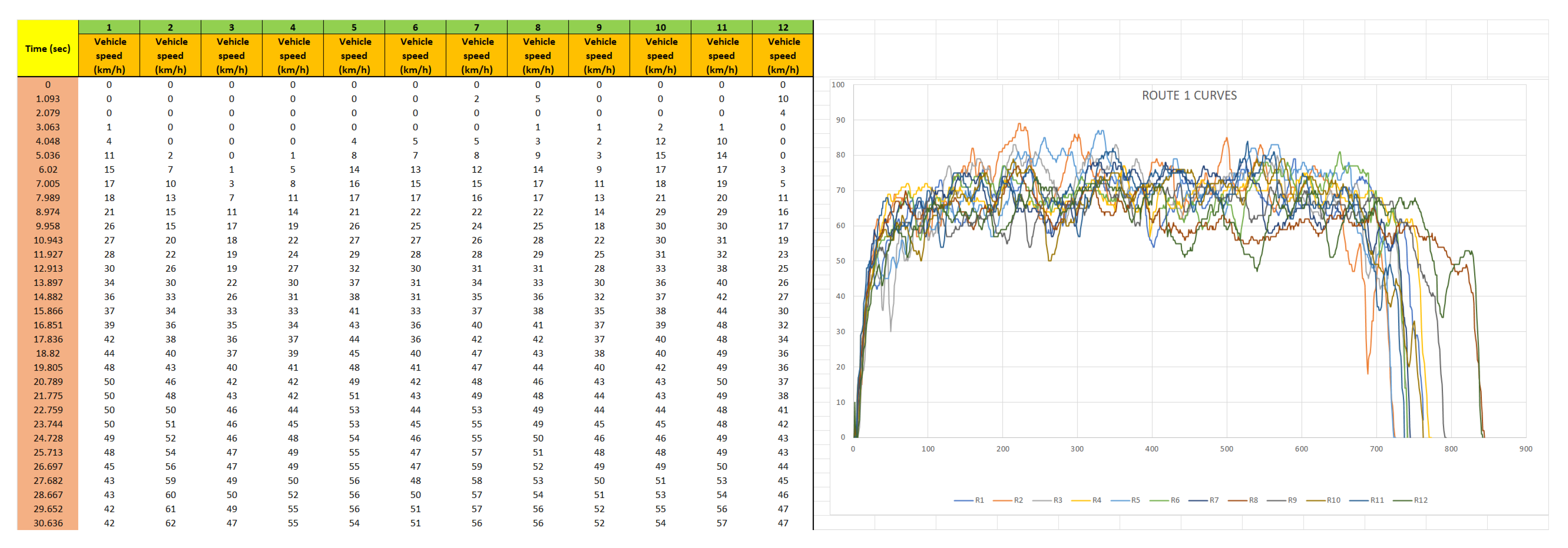
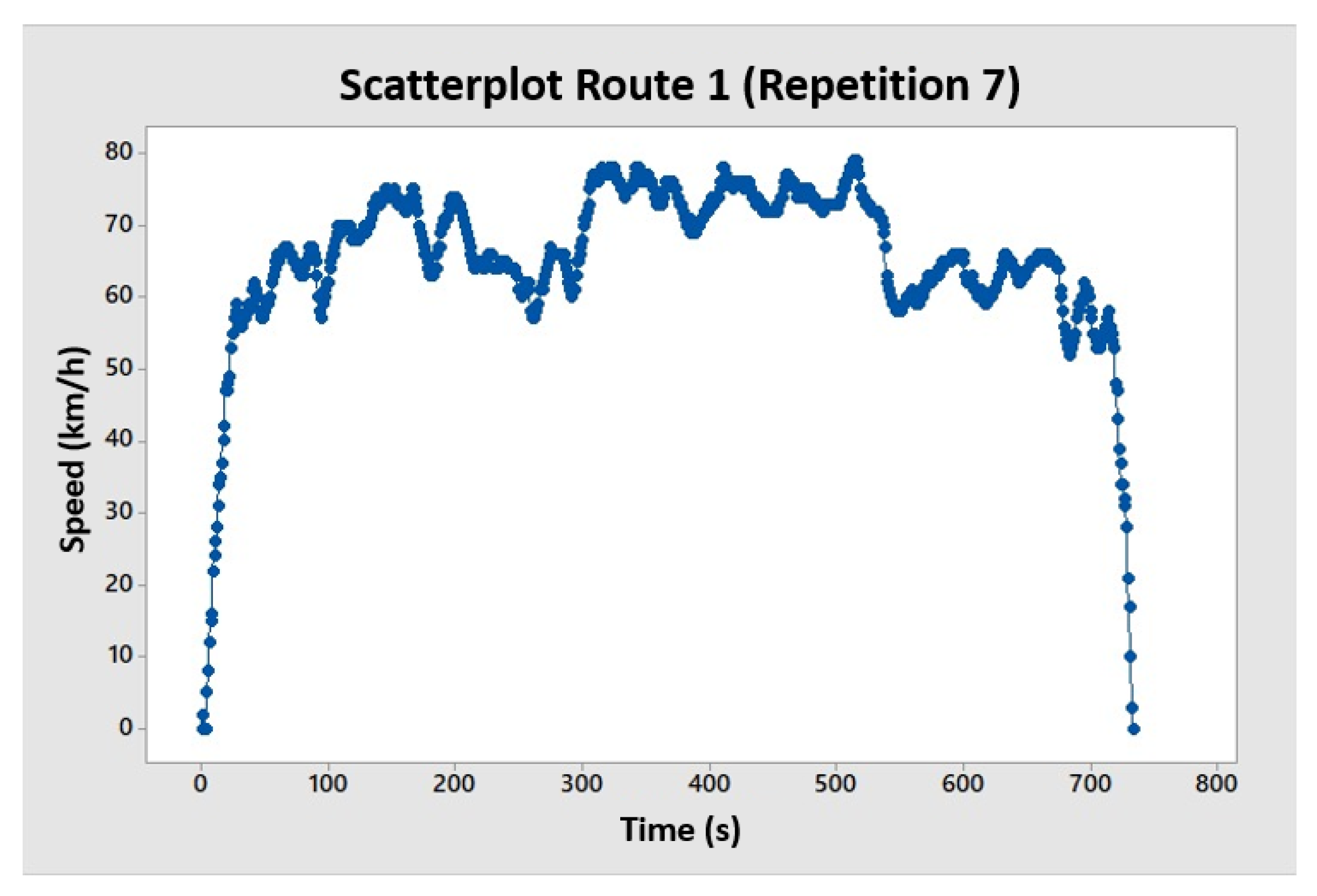



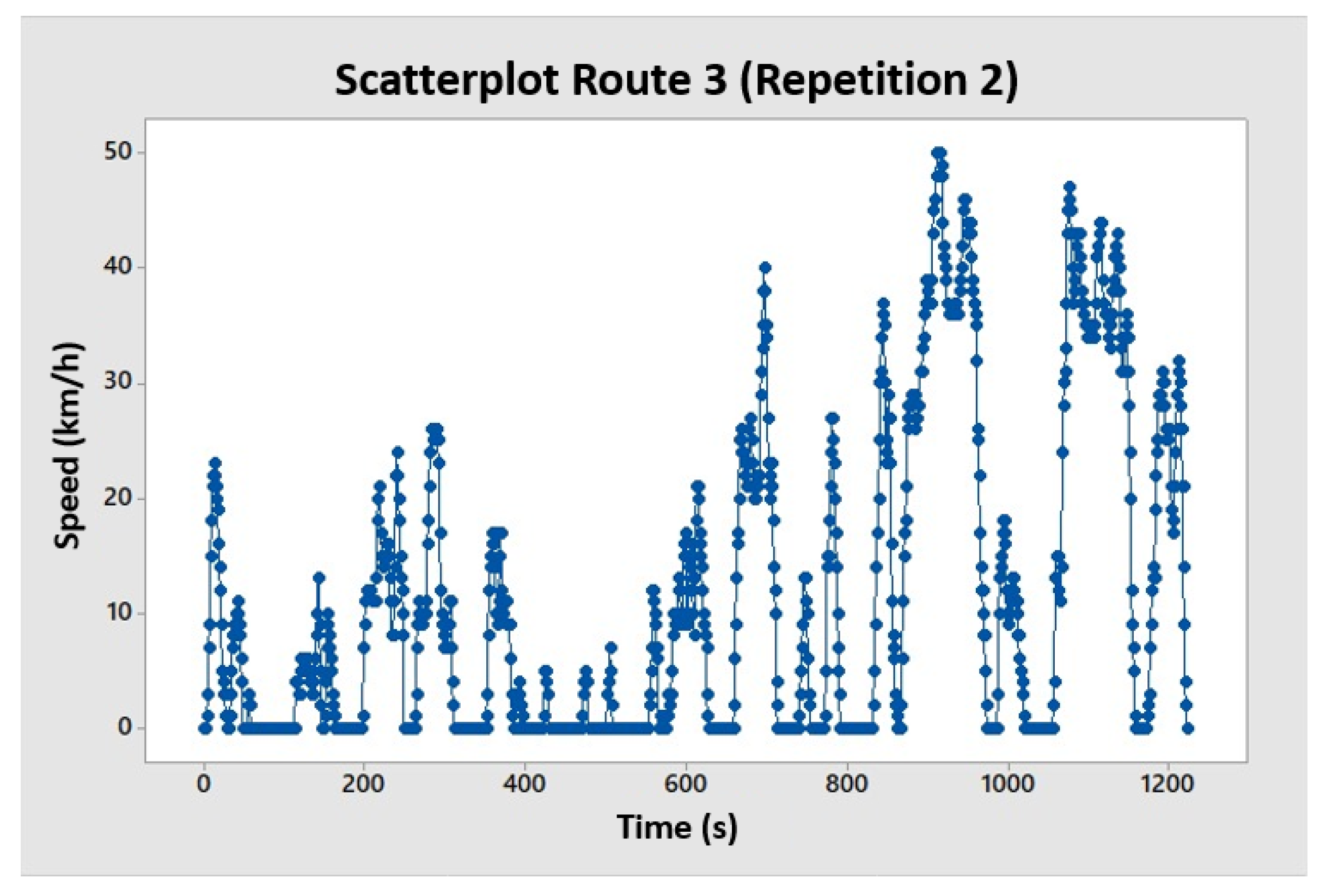


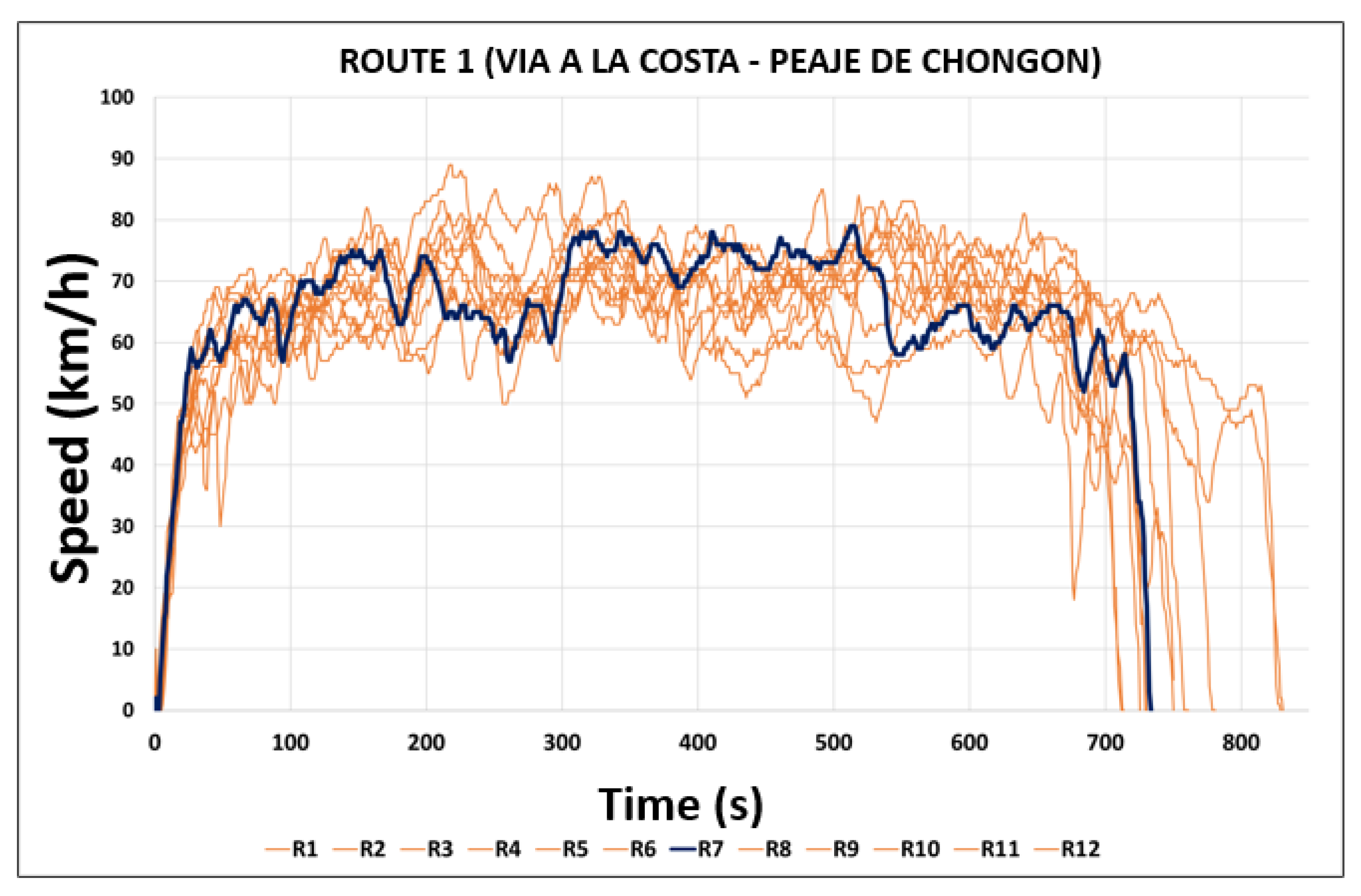
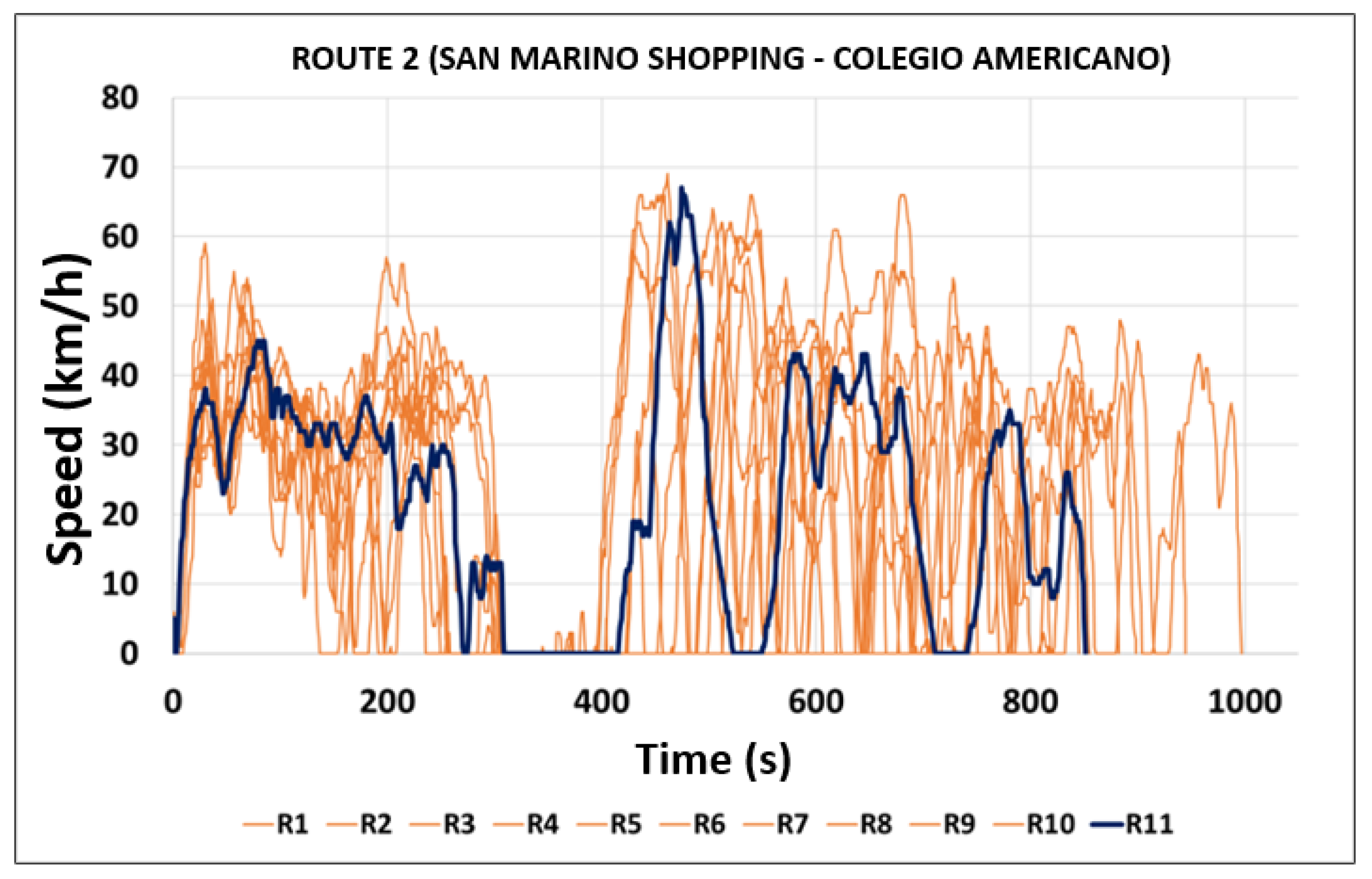
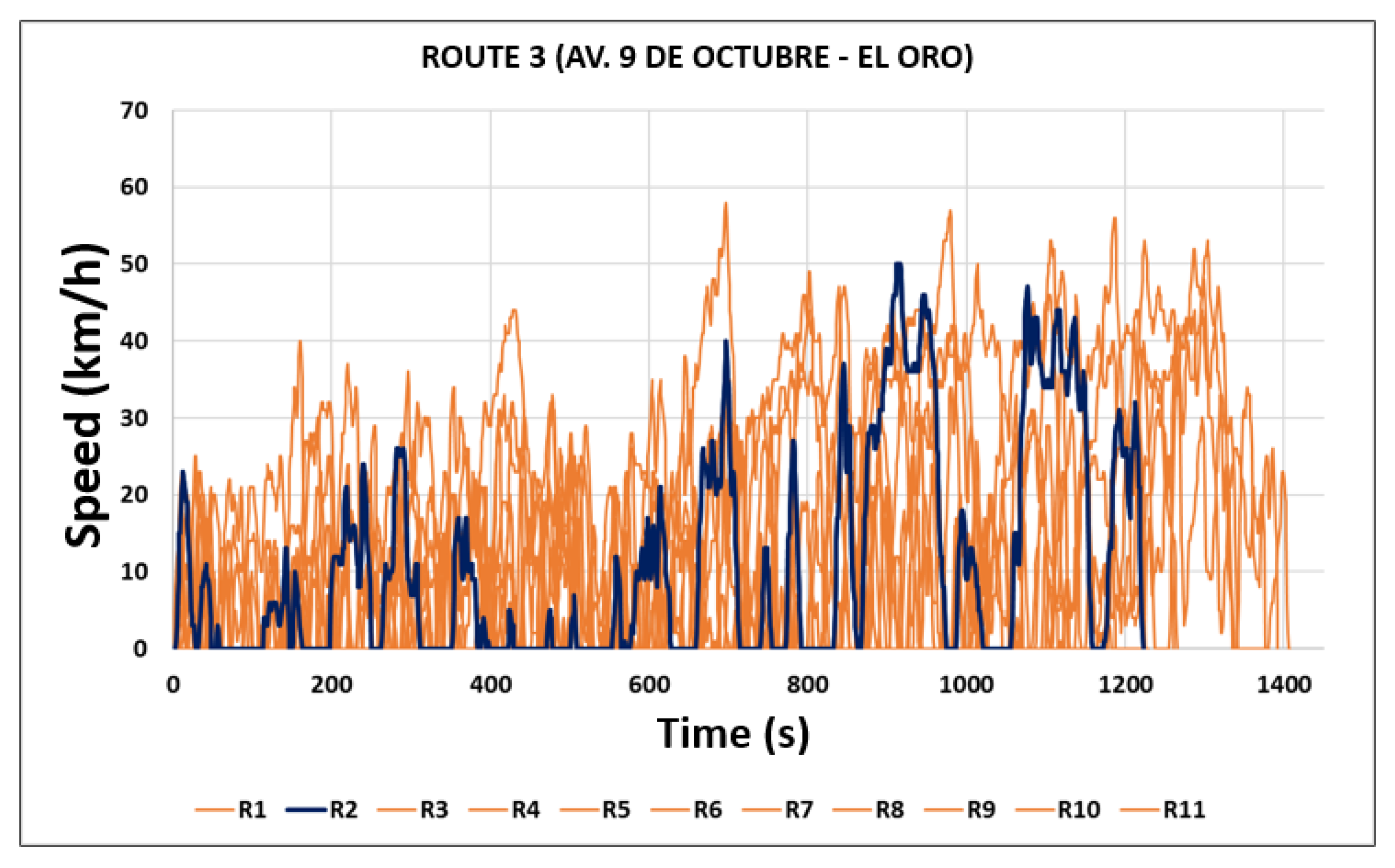

References
- Chauhan, B.P.; Joshi, G.J.; Parida, P. Development of candidate driving cycles for an urban arterial corridor of Vadodara city. Eur. Transp.-Trasp. Eur. 2020, 4, 1–16. [Google Scholar]
- Lema, J. Emisiones y temperaturas de los gases de escape de un motor durante el arranque en frío aplicando dos tipos de combustibles. Polo Del Conoc. Rev.-Científico-Prof. 2022, 7, 138–160. [Google Scholar]
- Serrano, L.; Santana, B.; Pires, N.; Correia, C. Performance, Emissions, and Efficiency of Biodiesel versus Hydrotreated Vegetable Oils (HVO), Considering Different Driving Cycles Sensitivity Analysis (NEDC and WLTP). Fuels 2021, 2, 448–470. [Google Scholar] [CrossRef]
- Leykun, M.G.; Mekonen, M.W. Investigation of the performance and emission characteristics of diesel engine fueled with biogas-diesel dual fuel. Fuels 2022, 3, 15–30. [Google Scholar] [CrossRef]
- Macioszek, E. Analysis of the volume of passengers and cargo in rail and road transport in Poland in 2009–2019. Sci. J. Silesian Univ. Technol. Ser. Transp. 2021, 113, 133–143. [Google Scholar] [CrossRef]
- Tong, H.Y.; Ng, K.W. Developing electric bus driving cycles with significant road gradient changes: A case study in Hong Kong. Sustain. Cities Soc. 2023, 98, 104819. [Google Scholar] [CrossRef]
- Grüner, J.; Marker, S. A tool for generating individual driving cycles-IDCB. SAE Int. J. Commer. Veh. 2016, 9, 417–428. [Google Scholar] [CrossRef]
- Gebisa, A.; Gebresenbet, G.; Gopal, R.; Nallamothu, R.B. Driving cycles for estimating vehicle emission levels and energy consumption. Future Transp. 2021, 1, 615–638. [Google Scholar] [CrossRef]
- Giraldo, M.; Huertas, J.I. Real emissions, driving patterns and fuel consumption of in-use diesel buses operating at high altitude. Transp. Res. Part D Transp. Environ. 2019, 77, 21–36. [Google Scholar] [CrossRef]
- Quiroga Villca, E. Ciclos de conducción en la perspectiva de homologación del vehículo en pendiente, Ciudad de La Paz-Bolivia. Rev. Tecnológica 2023, 19, 12–15. [Google Scholar]
- Campaña, G.G.R.; Castro, E.H.G.; González, N.A.O. Evaluación del ciclo de operación en el transporte público de la Ciudad de Quito. Polo del Conoc. 2024, 9, 4031–4055. [Google Scholar] [CrossRef]
- Salazar Sabas, O.A.; Quezada, B.E. Development of a driving cycle based on commercial vehicles and pollutant emissions. Rev. Int. Contam. Ambient. 2023, 39, 105–115. [Google Scholar] [CrossRef]
- Zaragoza, C. Nuevos Ciclos de Conducción para Homologar Emisiones Contaminantes. Revista Tecnica de Centro Zaragosa. 2018. Available online: https://revistacentrozaragoza.com/%EF%BB%BFnuevos-ciclos-de-conduccion-para-homologar-emisiones-contaminantes/ (accessed on 2 January 2025).
- Bagheri, E.; Masih-Tehrani, M.; Azadi, M.; Moosavian, A.; Sayegh, S.; Hakimollahi, M. Unveiling the impact of date-specific analytics on vehicle fuel consumption and emissions: A case study of Shiraz city. Heliyon 2024, 10, e36713. [Google Scholar] [CrossRef]
- Mayakuntla, S.K.; Verma, A. A novel methodology for construction of driving cycles for Indian cities. Transp. Res. Part D Transp. Environ. 2018, 65, 725–735. [Google Scholar] [CrossRef]
- Huzayyin, O.A.; Salem, H.; Hassan, M.A. A representative urban driving cycle for passenger vehicles to estimate fuel consumption and emission rates under real-world driving conditions. Urban Clim. 2021, 36, 100810. [Google Scholar] [CrossRef]
- Guashpa, F.O.C.; Parrales, A.E.M.; Quiroz, W.V.P.; Ibarra, V.W.G. Determinación de un ciclo de conducción eficiente para la ciudad de Esmeraldas. Cienc. Lat. Rev. Científica Multidiscip. 2023, 7, 1679–1691. [Google Scholar] [CrossRef]
- Llerena Viteri, D.R. Construcción del ciclo de conducción en la carretera Ambato-Riobamba; Technical Report; Escuela Superior Politécnica de Chimborazo: Chimborazo, Ecuador, 2022. [Google Scholar]
- Pérez Llanos, P.S.; Quito Sinchi, C.O. Determinación de los ciclos de conducción de un vehículo categoría M1 para la ciudad de Cuenca. Bachelor’s Thesis, Universidad Politécnica Salesiana, Quito, Ecuador, 2018. [Google Scholar]
- Ali, A.; Ayad, A.; Asfoor, M. Optimal charge scheduling and on-board control of an urban electrified BRT fleet considering synthetic representative driving cycles. Sci. Rep. 2024, 14, 5543. [Google Scholar] [CrossRef]
- Zeng, J.; Qian, Y.; Yin, F.; Zhu, L.; Xu, D. A multi-value cellular automata model for multi-lane traffic flow under Lagrange coordinate. Comput. Math. Organ. Theory 2022, 28, 178–192. [Google Scholar] [CrossRef]
- González-Oropeza, R. Los ciclos de manejo, una herramienta útil si es dinámica para evaluar el consumo de combustible y las emisiones contaminantes del auto transporte. Ing. Investig. Tecnol. 2005, 6, 147–162. [Google Scholar] [CrossRef]
- Guaillas Paqui, J.D.; Samaniego Marín, P.A. Determinación del ciclo real de conducción de un autobús de servicio urbano en la Ciudad de Loja para la evaluación de consumo de energía; Technical Report; Escuela Superior Politécnica de Chimborazoo: Chimborazo, Ecuador, 2024. [Google Scholar]
- Giraldo, M.; Quirama, L.F.; Huertas, J.I.; Tibaquirá, J.E. The effect of driving cycle duration on its representativeness. World Electr. Veh. J. 2021, 12, 212. [Google Scholar] [CrossRef]
- Instituto Ecuatoriano de Normalización (INEN). RTE-002: Reglamento Técnico Ecuatoriano—[Emisiones de Vehiculos Automotores y Motores de Vehiculos Usados]; INEN: Quito, Ecuador, 1996. Available online: https://www.normalizacion.gob.ec/buzon/reglamentos/RTE-002.pdf (accessed on 10 January 2025).
- Instituto Ecuatoriano de Normalización (INEN). Inspección de Vehículos Automotores bajo Reglamentos Técnicos INEN; INEN: Quito, Ecuador, 2024. Available online: https://www.normalizacion.gob.ec/inspeccion-de-vehiculos-automotores-bajo-reglamentos-tecnicos-inen/ (accessed on 11 January 2025).
- Municipalidad de Guayaquil. Evaluación Socioeconómica: Construcción de la Infraestructura de Movilidad Urbana Sostenible (Parque Lineal) en la Coop. Jardines del Salado; Dirección General de Obras Públicas—Subdirección de Estudios y Proyectos: Guayaquil, Ecuador, Julio. 2024. Available online: https://www.guayaquil.gob.ec/wp-content/uploads/Documentos/UPFE-CAF/UPFE%202024/PE-MIMG-2024-6/PREPARATORIA/14.%20INFORMES/SOCIOECON%C3%93MICO/EVALUACI%C3%93NSOCIOECON%C3%93MICA-2024-signed-signed-signed.pdf (accessed on 15 January 2025).
- Pouresmaeili, M.A.; Aghayan, I.; Taghizadeh, S.A. Development of Mashhad driving cycle for passenger car to model vehicle exhaust emissions calibrated using on-board measurements. Sustain. Cities Soc. 2018, 36, 12–20. [Google Scholar] [CrossRef]
- Municipalidad de Guayaquil. Modificación a la resolución del proyecto “Fortalecimiento de la red vial urbana con la implementación de soluciones viales en la ciudad de Guayaquil: Solución vial 3, intersección Av. Juan Tanca Marengo con Av. Rodrigo Chávez González y obras complementarias” (anuncio publicado en el sitio web). Alcaldía de Guayaquil, 15 de abril 2024. Available online: https://www.guayaquil.gob.ec/modificatoria-anuncio-proyecto-fortalecimiento-red-vial-urbana-implementacion-soluciones-viales-ciudad-guayaquil/ (accessed on 10 January 2025).
- Agencia Metropolitana de Tránsito de Guayaquil (ATM). Informe de Rendición de Cuentas 2023; ATM: Guayaquil, Ecuador, 22 February 2024. Available online: https://www.atm.gob.ec/dcom/transparencia/2024/Rendici%C3%B3n_Cuentas_2023/InformeRendicionCuentas2023_paraCCPCS_Vfinal.pdf (accessed on 12 January 2025).
- El Universo. Los horarios de mayor tráfico vehicular en Guayaquil y Samborondón. *El Universo* (Guayaquil), 17 May 2022. Available online: https://www.eluniverso.com/guayaquil/comunidad/los-horarios-de-mayor-trafico-vehicular-en-guayaquil-y-samborondon-nota/ (accessed on 15 January 2025).
- El Universo. El 23% del suelo urbano de Guayaquil se concentra en el sector de la vía a la costa, considerado el nuevo polo de desarrollo donde se construirá el aeropuerto de Daular. *El Universo* (Guayaquil), 12 April 2022. Available online: https://www.eluniverso.com/guayaquil/via-costa/el-23-del-suelo-urbano-de-guayaquil-se-concentra-en-el-sector-de-via-a-la-costa-considerado-el-nuevo-polo-de-desarrollo-donde-se-construira-el-aeropuerto-de-daular-nota/ (accessed on 15 January 2025).
- El Universo. El área rural de expansión urbana en sector de vía a la costa abarca 1 193.6 hectáreas. *El Universo* (Guayaquil), 15 April 2022. Available online: https://www.eluniverso.com/guayaquil/via-costa/el-area-rural-de-expansion-urbana-en-sector-de-via-a-la-costa-abarca-11936-hectareas-nota/?outputType=amp (accessed on 15 January 2025).
- Asociación de Empresas Automotrices del Ecuador (AEADE). Anuario 2023; AEADE: Quito, Ecuador, 2023; Available online: https://www.aeade.net/wp-content/uploads/2024/03/AEADE-2023.pdf (accessed on 20 January 2025).
- OBD Solutions, LLC. OBDLink MX Bluetooth Scan Tool—Specifications and Features; OBDLink: Heber City, UT, USA, 2025; Available online: https://www.obdlink.com/obdlink-mx-bluetooth/ (accessed on 20 December 2024).
- ISO 15765-4:2016; Road Vehicles—Diagnostic Communication over Controller Area Network (DoCAN)—Part 4: Requirements for Emissions-Related Systems; ISO: Geneva, Switzerland. 2016. Available online: https://www.iso.org/standard/78384.html (accessed on 20 January 2025).
- Visconti, P.; Rausa, G.; Del-Valle-Soto, C.; Velázquez, R.; Cafagna, D.; De Fazio, R. Innovative Driver Monitoring Systems and On-Board-Vehicle Devices in a Smart-Road Scenario Based on the Internet of Vehicle Paradigm: A Literature and Commercial Solutions Overview. Sensors 2025, 25, 562. [Google Scholar] [CrossRef] [PubMed]
- Rivera-Campoverde, N.D.; Arenas-Ramírez, B.; Muñoz Sanz, J.L.; Jiménez, E. GPS Data and Machine Learning Tools, a Practical and Cost-Effective Combination for Estimating Light Vehicle Emissions. Sensors 2024, 24, 2304. [Google Scholar] [CrossRef] [PubMed]
- Tocoronte, E.M.; Zuñiga, K.N.G.Z.G. Sofware minitab en la predicción del tiempo estándar. Sapientia Technol. 2021, 2, 19. [Google Scholar]
- López-Chila, R.; Arteaga-Sotomayor, J.; Caballero-Barros, E.; Llerena-Izquierdo, J. An e-learning evaluation method with the effectiveness of the questionnaire tool in the VLEs. In Proceedings of the 2023 IEEE World Engineering Education Conference (EDUNINE), Bogota, Colombia, 12–15 March 2023; pp. 1–6. [Google Scholar] [CrossRef]
- Valdéz Aguilera, A. Desarrollo de Ciclos de Conducción Vehicular en el Municipio de Naucalpan—Edición Única. Master’s Thesis, Instituto Tecnológico y de Estudios Superiores de Monterrey, Monterrey, México, 2004. Available online: http://hdl.handle.net/11285/572354 (accessed on 20 January 2025).
- Quinchimbla Pisuña, F.E.; Solís Santamaría, J.M. Desarrollo de ciclos de conducción en ciudad, carretera y combinado para evaluar el rendimiento real del combustible de un vehículo con motor de ciclo Otto en el Distrito Metropolitano de Quito. Master’s Thesis, Escuela Politécnica Nacional, Quito, Ecuador, 2017. Available online: https://bibdigital.epn.edu.ec/handle/15000/17000 (accessed on 21 January 2025).
- Hyndman, R.J.; Athanasopoulos, G. Forecasting: Principles and Practice; OTexts: Chula Vista, CA, USA, 2018. [Google Scholar]
- Tufte, E.R.; Graves-Morris, P.R. The Visual Display of Quantitative Information; Graphics Press: Cheshire, CT, USA, 1983; Volume 2. [Google Scholar]
- Few, S. Now You See It: Simple Visualization Techniques for Quantitative Analysis; Analytics Press: Berkeley, CA, USA, 2009. [Google Scholar]
- López-Chila, R.; Sumba-Nacipucha, N.; Llerena-Izquierdo, J. Effectiveness of digital resources for cloned Linear Algebra courses at the undergraduate level. In Proceedings of the 2023 IEEE World Engineering Education Conference (EDUNINE), Bogota, Colombia, 12–15 March 2023; pp. 1–5. [Google Scholar] [CrossRef]
- Barlow, T.J.; Latham, S.; McCrae, I.S.; Boulter, P.G. A Reference Book of Driving Cycles for Use in the Measurement of Road Vehicle Emissions; Published Project Report PPR 354; TRL Limited: Bracknell, Berkshire, UK, 2009. Available online: https://assets.publishing.service.gov.uk/government/uploads/system/uploads/attachment_data/file/4247/ppr-354.pdf (accessed on 20 December 2024).
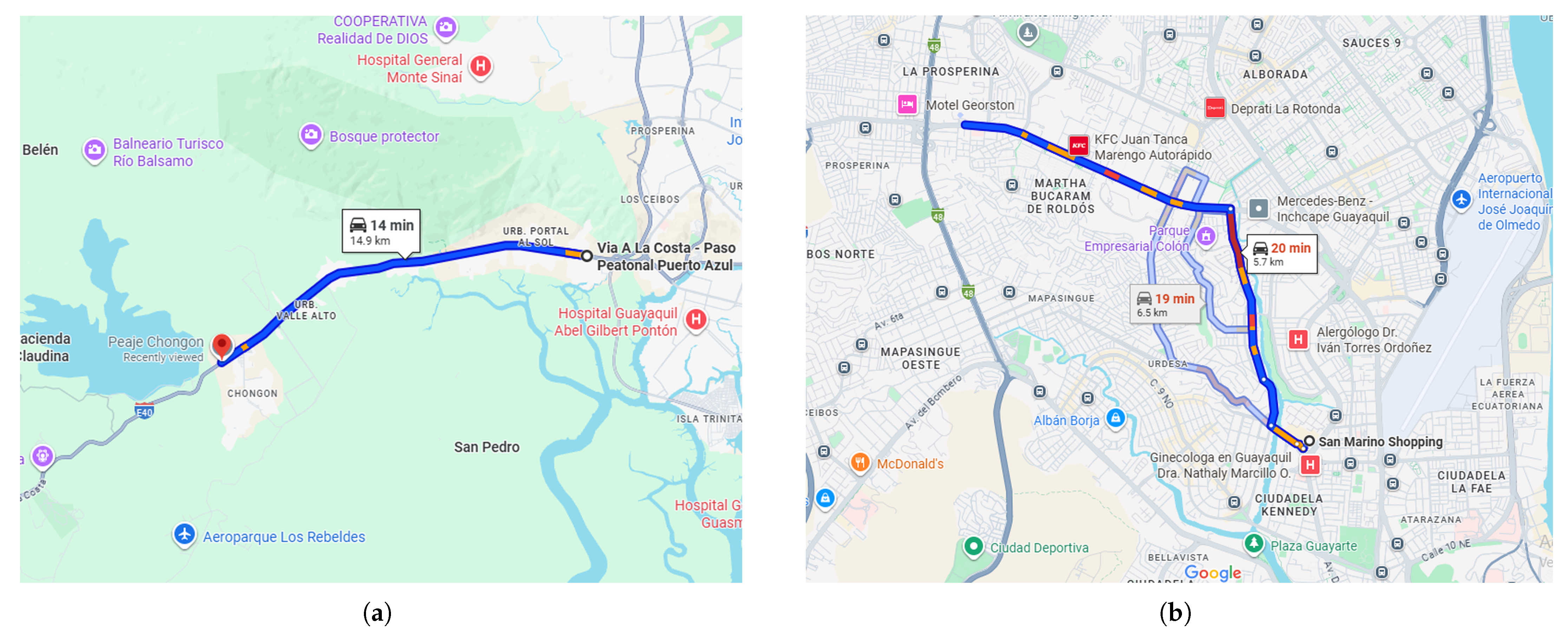


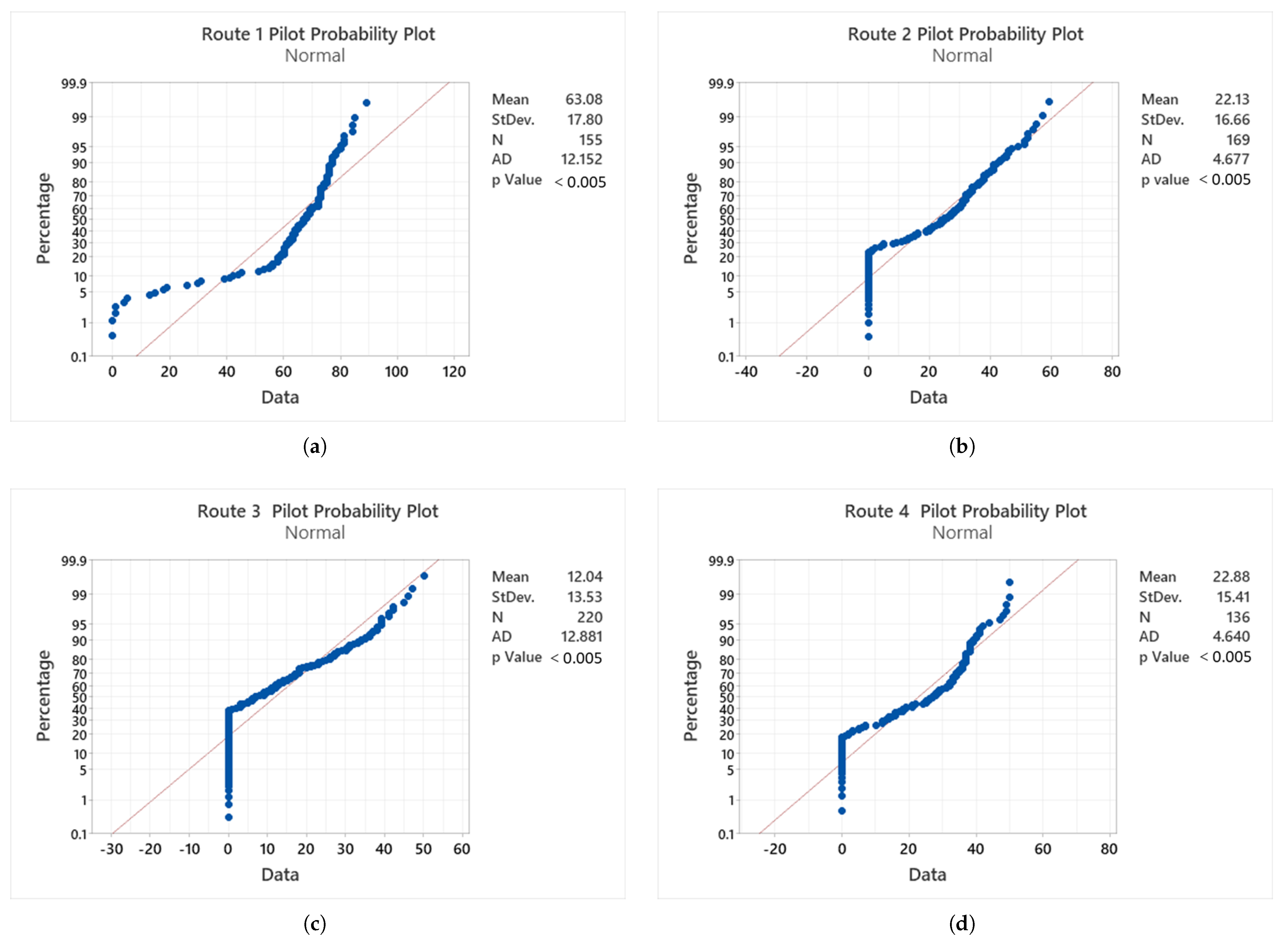




| Vehicle Data | |
|---|---|
| Brand | Chevrolet |
| Model | Emotion |
| Year | 2015 |
| Fuel | Gasoline |
| Displacement | 4 cylinders, 1.8L |
| Type | DOCH 16V |
| Power | 103 Hp @ 6000 RPM |
| Torque | 144.1 Nm @ 3600 RPM |
| Mileage (km) | 533,400 |
| Variables analyzed |
|---|
| Controllable variables |
| Distance (km) |
| Time (s) |
| Non-controllable variables |
| Ambient temperature (Celsius) |
| Altitude (m.s.n.m.) |
| Wind speed (m/s) |
| Route conditions (regular) |
| Response variable |
| Maximum speed (km/h) |
| Average speed (km/h) |
| Number of stops (N) |
| Idle time (s) |
| Positive acceleration time (s) |
| % of driving time |
| % of time accelerating |
| Variables | Weightings (Wi) |
|---|---|
| Maximum speed (km/h) | 1 |
| Average speed (km/h) | 0.25 |
| Number of stops | 1 |
| Driving time (s) | 0.25 |
| Idle time (s) | 0.75 |
| Distance traveled (m) | 1 |
| Positive acceleration time (s) | 0.25 |
| % of driving time | 1 |
| % of time accelerating | 1 |
| Tours | Routes | Distance (km) | Time (s) | Average Speed (km/h) |
|---|---|---|---|---|
| Vía a la Costa-Peaje | 1 | 14.9 | 777.139 | 63.94 |
| San Marino-Colegio Americano | 2 | 5.7 | 839.934 | 22.22 |
| Av. 9 de Octubre-El Oro | 3 | 3.9 | 1111.917 | 11.93 |
| UPS Centenario-17th Street and Portete | 4 | 4.7 | 681.925 | 22.96 |
| Routes | Tours | Standard Deviation | Standard Error | Sample Size | Total Number of Repetitions |
|---|---|---|---|---|---|
| 1 | Vía a la Costa-Peaje | 18.45 | 0.617 | 1836 | 12 |
| 2 | San Marino-Colegio Americano | 17.87 | 0.643 | 1594 | 11 |
| 3 | Av. 9 de Octubre-El Oro | 13.527 | 0.402 | 2308 | 11 |
| 4 | UPS Centenario-17th Street and Portete | 15.48 | 0.585 | 1450 | 11 |
| Route | Rep. # | Avg. Speed | Max Speed | Idle Time | Stops | Distance | Drive Time |
|---|---|---|---|---|---|---|---|
| (km/h) | (km/h) | (s) | (N) | (m) | (s) | ||
| Route 1 | 7 | 65.39 | 79 | 10 | 0 | 14,901 | 735.62 |
| Route 2 | 11 | 21.39 | 67 | 243 | 4 | 5712 | 850.09 |
| Route 3 | 2 | 11.05 | 50 | 613 | 18 | 3900 | 1223.42 |
| Route 4 | 5 | 16.27 | 39 | 247 | 11 | 4689 | 961.22 |
| Route | Repetition # | Min Y | Avg. Speed (km/h) | Max Speed (km/h) | Idle Time (s) |
|---|---|---|---|---|---|
| Route 1 | 7 | 0.0142 | 65.39 | 79 | 10 |
| Route 2 | 11 | 0.0324 | 21.39 | 67 | 243 |
| Route 3 | 2 | 0.0171 | 11.05 | 50 | 613 |
| Route 4 | 5 | 0.0353 | 16.27 | 39 | 247 |
| Average Speed (km/h) | Maximum Speed (km/h) | N | Driving Time (s) | Idle Time (s) | Distance (m) | Positive Acceleration Time (s) | % of Driving Time | % of Time Accelerating |
|---|---|---|---|---|---|---|---|---|
| 65.39 | 79 | 0 | 735.62 | 10 | 14,901 | 556 | 98.64 | 75.58 |
| Average Speed (km/h) | Maximum Speed (km/h) | N | Driving Time (s) | Idle Time (s) | Distance (m) | Positive Acceleration Time (s) | % of Driving Time | % of time Accelerating |
|---|---|---|---|---|---|---|---|---|
| 21.39 | 67 | 4 | 850.091 | 243 | 5712 | 306 | 71.41 | 36.00 |
| Average Speed (km/h) | Maximum Speed (km/h) | N | Driving Time (s) | Idle Time (s) | Distance (m) | Positive Acceleration Time (s) | % of Driving Time | % of Time Accelerating |
|---|---|---|---|---|---|---|---|---|
| 11.05 | 50 | 18 | 1223.416 | 613 | 3900 | 332 | 49.89 | 27.14 |
| Average Speed (km/h) | Maximum Speed (km/h) | N | Driving Time (s) | Idle Time (s) | Distance (m) | Positive Acceleration Time (s) | % of Driving Time | % of Time Accelerating |
|---|---|---|---|---|---|---|---|---|
| 16.27 | 39 | 11 | 961.22 | 247 | 4689 | 374 | 74.30 | 38.91 |
| Parameters | Guayaquil/ Route 1 | Guayaquil/ Route 2 | Guayaquil/ Route 3 | Guayaquil/ Route 4 | WSL Congested Traffic Cycle | FTP-75 | HWFET | NEDC |
|---|---|---|---|---|---|---|---|---|
| Average speed (km/h) | 65.39 | 21.39 | 11.05 | 16.27 | 6.7 | 34.20 | 77.7 | 33.60 |
| Maximum speed (km/h) | 79 | 67 | 50 | 39 | 43.65 | 91.09 | 96.32 | 120.09 |
| Number of stops | 0 | 4 | 18 | 11 | 22 | 16 | 0 | 14 |
| Driving time (s) | 735.624 | 850.091 | 1223.416 | 961.223 | 838 | 1633.00 | 764 | 939.00 |
| Idle time (s) | 10 | 243 | 613 | 247 | 191 | 241 | 1 | 241 |
| Distance (m) | 14,901 | 5712 | 3900 | 4689 | 1920.59 | 17,786.59 | 16,503.13 | 11,016.63 |
| Acceleration time (s) | 556 | 306 | 332 | 374 | 314 | 683 | 264 | 278 |
| % of driving time | 98.64 | 71.41 | 49.89 | 74.3 | 81.44 | 87.14 | 99.87 | 79.58 |
| % of time accelerating | 75.58 | 36.00 | 27.14 | 38.91 | 30.52 | 36.45 | 34.51 | 23.56 |
| Parameters | Guayaquil/ Route 1 | Guayaquil/ Route 2 | Guayaquil/ Route 3 | Guayaquil/ Route 4 | Cuenca | Quito/ City | Quito/ Highway | Quito/ Combined |
|---|---|---|---|---|---|---|---|---|
| Average speed (km/h) | 65.39 | 21.39 | 11.05 | 16.27 | 26.09 | 13.26 | 65.98 | 19.18 |
| Maximum speed (km/h) | 79 | 67 | 50 | 39 | 61 | 45.77 | 89.91 | 78.32 |
| Number of stops | 0 | 4 | 18 | 11 | 12 | 58 | 2 | 63 |
| Driving time (s) | 735.624 | 850.091 | 1223.416 | 961.223 | 1168 | 3169.00 | 1493.00 | 2889.00 |
| Idle time (s) | 10 | 243 | 613 | 247 | 280 | 1060 | 10 | 960 |
| Distance (m) | 14,901 | 5712 | 3900 | 4689 | 10,494 | 11,914 | 27,463 | 15,673 |
| Acceleration time (s) | 556 | 306 | 332 | 374 | 530 | 1266 | 791 | 1036 |
| % of driving time | 98.64 | 71.41 | 49.89 | 74.3 | 81 | - | - | - |
| % of time accelerating | 75.58 | 36.00 | 27.14 | 38.91 | 36.6 | - | - | - |
| Parameters | Guayaquil/ Route 1 | Guayaquil/ Route 2 | Guayaquil/ Route 3 | Guayaquil/ Route 4 | Esmeraldas | Ambato– Riobamba/ Highway | Ambato– Riobamba/ Urban |
|---|---|---|---|---|---|---|---|
| Average speed (km/h) | 65.39 | 21.39 | 11.05 | 16.27 | 36.20 | 60.95 | 26.52 |
| Maximum speed (km/h) | 79 | 67 | 50 | 39 | - | 120.40 | 63.40 |
| Number of stops | 0 | 4 | 18 | 11 | - | 2 | 13 |
| Driving time (s) | 735.624 | 850.091 | 1223.416 | 961.223 | 1750 | 2500 | 1300 |
| Idle time (s) | 10 | 243 | 613 | 247 | - | - | - |
| Distance traveled (m) | 14,901 | 5712 | 3900 | 4689 | 15,420 | - | - |
| Acceleration time (s) | 556 | 306 | 332 | 374 | - | - | - |
| % of driving time | 98.64 | 71.41 | 49.89 | 74.3 | - | 96.06 | 81.28 |
| % of time accelerating | 75.58 | 36 | 27.14 | 38.91 | - | - | - |
Disclaimer/Publisher’s Note: The statements, opinions and data contained in all publications are solely those of the individual author(s) and contributor(s) and not of MDPI and/or the editor(s). MDPI and/or the editor(s) disclaim responsibility for any injury to people or property resulting from any ideas, methods, instructions or products referred to in the content. |
© 2025 by the authors. Licensee MDPI, Basel, Switzerland. This article is an open access article distributed under the terms and conditions of the Creative Commons Attribution (CC BY) license (https://creativecommons.org/licenses/by/4.0/).
Share and Cite
López-Chila, R.; Abad-Reyna, H.; Morocho-Cajas, J.; Fierro-Jimenez, P. Development of Representative Urban Driving Cycles for Congested Traffic Conditions in Guayaquil Using Real-Time OBD-II Data and Weighted Statistical Methods. Vehicles 2025, 7, 95. https://doi.org/10.3390/vehicles7030095
López-Chila R, Abad-Reyna H, Morocho-Cajas J, Fierro-Jimenez P. Development of Representative Urban Driving Cycles for Congested Traffic Conditions in Guayaquil Using Real-Time OBD-II Data and Weighted Statistical Methods. Vehicles. 2025; 7(3):95. https://doi.org/10.3390/vehicles7030095
Chicago/Turabian StyleLópez-Chila, Roberto, Henry Abad-Reyna, Joao Morocho-Cajas, and Pablo Fierro-Jimenez. 2025. "Development of Representative Urban Driving Cycles for Congested Traffic Conditions in Guayaquil Using Real-Time OBD-II Data and Weighted Statistical Methods" Vehicles 7, no. 3: 95. https://doi.org/10.3390/vehicles7030095
APA StyleLópez-Chila, R., Abad-Reyna, H., Morocho-Cajas, J., & Fierro-Jimenez, P. (2025). Development of Representative Urban Driving Cycles for Congested Traffic Conditions in Guayaquil Using Real-Time OBD-II Data and Weighted Statistical Methods. Vehicles, 7(3), 95. https://doi.org/10.3390/vehicles7030095






